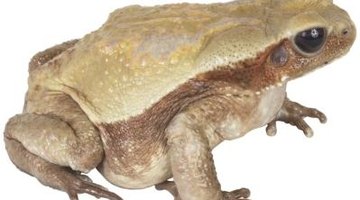How to Get Rid of Frogs in a Pond
Gobbling up insects that damage plants, frogs are often considered beneficial for garden areas. Yet frogs can also overtake ponds, making lots of noise that you may find annoying. Frogs are attracted to a pond for feeding and breeding purposes. If frogs have invaded your garden pond, all hope is not lost.

Things You Will Need
- Bird netting
- Pesticides
- Fish
- Fountains
- Bucket
- Stick or broom handle
Tip
Some choose to use scent repellents such as snake repellent to deter frogs. Frogs have limited smelling ability, however, so scent repellents are often ineffective.
Warning
Leaving out poisons to kill off the frogs is not always a good idea. Killing native frogs is illegal; it is only legal to kill non-native species of frogs. Check with your local county extension service or government to determine a best plan of action regarding poisoning frogs.
Control methods are available to eliminate or seriously slim down your pond's frog population.
-
Place a net around your pond. Use bird netting material to make a finished net fence at least 2 feet tall and buried at least 6 inches in the ground. This discourages frogs from hopping over the net as well as crawling under. A net prevents new frogs from entering your pond area while you deal with the ones already inside. After eliminating the frogs in your pond, the fence prevents reinfestation.
-
Use pesticides to eliminate the insect population the frogs in your pond feed on. Treat the area around your pond and any gutters, lights, piles of leaves and areas with plants. Killing off the insects eliminates the frogs' main source of food, encouraging them to hang out someplace besides your pond.
-
Plants provide hiding places for frogs, so remove them from inside and around your pond. Without shelter, the frogs will relocate.
-
Add fish to your pond to increases water movement and prevent frogs from breeding.
-
Increase water movement with fountains, water wheels, waterfalls or other things that move water. This discourages breeding, which in turn encourages frogs to move along.
-
Catch the frogs and relocate them. Place buckets around the pond area when frogs are noisiest and most active. Carefully prod the frogs into buckets with a stick or broom handle. Cover buckets to prevent frogs from escaping, then relocate them to a pond-like environment between at least a half mile from your home, advises the website Fish Pond Info.
References
Photo Credits
- PhotoObjects.net/PhotoObjects.net/Getty Images
- PhotoObjects.net/PhotoObjects.net/Getty Images
More Articles



